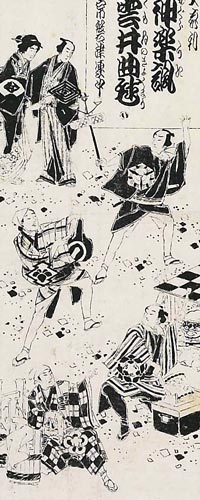| DONTSUKU |
| Play title | Kagura Uta Kumoi no Kyokumari |
| Common titles | Dontsuku |
| Author | Sakurada Jisuke III (lyrics) Kishizawa Shikisa V (music) |
| History |
Sakurada Jisuke III's Tokiwazu-based dance-drama "Kagura Uta Kumoi no Kyokumari" was premiered in the 1st lunar month of 1846 at the Nakamuraza [more details]. |
| Key words |
Chaya Nyôbô Daikagura Daiku Fujisan Hagoromo Hanabi Inaka Zamurai Kado Reisha Kakubę Kameido Tenjin Komori Machi Musume Miko Nimochi Shirozake Shosagoto Taiko Mochi Tobigashira Tokiwazu Wakadanna |
| Summary |
A number of people including a countryside samurai (inaka zamurai), a geisha, the mistress of a teahouse (chaya nyôbô), a pair of taiko mochi and a carpenter (daiku) are watching a traveling Daikagura performance made by master Tsurudayű [1] in the precincts of the Kameido Tenjin Shrine. They are joined by a shirozake seller who tells the story of the origin of shirozake in a cheerful and lively dance. The story is a fanciful account of a fisherman marrying an angel when he found her hagoromo or feathered robe and they stayed in each other's arms day and night, incidentally making shirozake, as white as the snows on top of Mt. Fuji. The mistress of the teahouse performs a romantic dance and is soon joined by the two taiko mochi who perform a colorful drinking game in the rhythm of the music. Now the master Tsurudayű and his luggage bearer Dontsuku perform Daikagura. Tsurutayű's performance is brisk and energetic. The rustic Dontsuku says that he has a dance that Edo people cannot imitate. It is simple, but becomes very fast. Then he explains the origin of his name Dontsuku in his dance. The word don means dull and a pattern like don don tsuku tsuku suggests the sound of the beating of a drum. Two of the women then perform a dance which is interrupted by Dontsuku imitating a miko by wearing the comical Okame mask. He describes the comic romantic encounter between Okame and the Daikagura performer who now plays the role of a Shintô priest. Finally they do an auspicious dance evoking red and black things, including red lightening breaking through the black clouds, a red-sheathed sword with a black silk kimono, red fireworks (hanabi) in a pitch-black night and black birds flying by the rising sun. This last section ends a colorful dance based on street performances of the Edo period. |
| Trivia |
It's said that Nakamura Utaemon IV based the character of Dontsuku, a slow-witted man from the countryside, on one of his disciples. This dance is closely associated to the Bandô Mitsugorô line of actors. There are several possible characters, depending on the production of this dance, which can appear on stage alongside the Daikagura performer and his luggage bearer: a wakadanna, a machi musume, a tobigashira, a komori, a kado reisha, two kakubę, ... |
| Notes |
 |
|
An illustration for the performance of "Dontsuku" in June 1921 in Nagoya at the Suehiroza |
|
|
| Contact | Main | Top | Updates | Actors | Plays | Playwrights | Programs | Links | FAQ | Glossary | Chronology | Illustrations | Prints | Characters | Derivatives | Theaters | Coming soon | News |